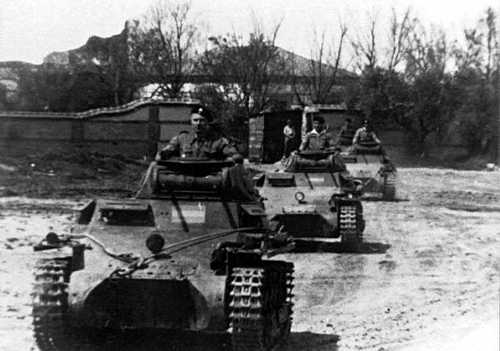
Panzers in Spain
PzKpfw I tanks of "Gruppe Drohne", the German panzer contingent of the Legion Condor. This formation was primarily a training unit, training Spanish Nationalist soldiers in tank tactics, maintenance, staff matters et cetera. However, German personnel also served on the front line in rotation; the commander of the formation, Oberstleutnant (later General der Panzertruppe) Wilhelm, Ritter von Thoma, claimed to have taken in over 180 armoured engagements in Spain. How important the panzer component in the Spanish Civil War may have been is hard to say. True, the war did give the Germans an opportunity to see tank tactics practiced in a live fire situation. However, Franco and the Nationalist generals - veterans to a man of the North African counter-insurgency campaigns of the Rif War - were fully conditioned to the requirements of a civil war in which it was necessary to grind down local opposition thoroughly, territory by territory, rather than bypass it. Their interest in blitzkrieg-type mobile warfare was intermittent at best, leaving the panzers mainly confined to an infantry-support role. Perhaps that is just as well, from the point of view of Nationalist tankers. In the course of the war, Germany supplied the Nationalists with some 180 PzKpfw I tanks (1 PzKpfw II was headed for Spain at the war's end, but ended up being repatriated to Germany). As against that, the Soviet Union supplied the Republicans with some 280 T-26 and 50 BT-5 machines. Thoma's boys determined that, firing steel-core armour piercing ammunition, the dual machine-gun armament of the PzKpfw I could disable a T-26 or BT-5 (which were scarcely better armoured than the Pz I) at short range. However, this was not much good - the Soviet machines all carried versions of the excellent (for the period) 45mm Soviet cannon; all the Spanish/Soviet tankers on the Republican side had to do was open fire at longer ranges to destroy a PzKpfw I, allowing the latter no opportunity to do more than scratch their paint. No wonder that captured Soviet tanks were greatly prized on the Nationalist side. The 50 captured T-26 that the Nationalists managed to return to action (overall number of this type captured was eventually of the order of 180) ended up constituting the most potent comoponent element of Franco's armoured force. Then again, the PzKpfw Is were undoubtedly quite effective in an infantry support role - as long as they did not encounter any T-26 or BT-5 along the way. Best regards, JR.
This is a companion discussion topic for the original entry at https://ww2incolor.com/gallery/other-forces/48523/panzers-in-spain
